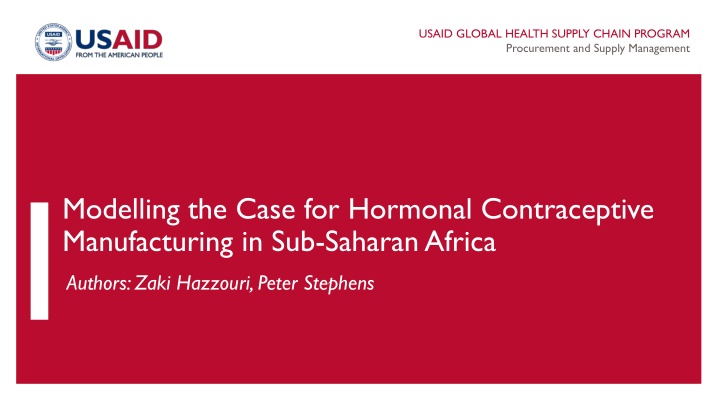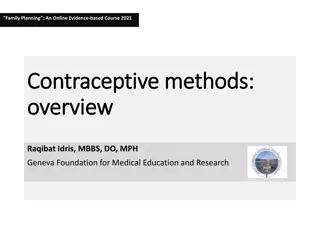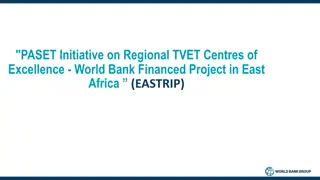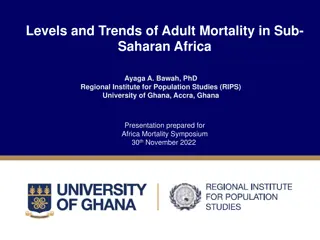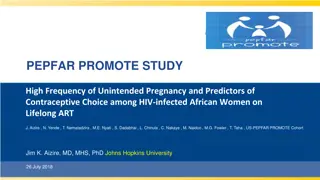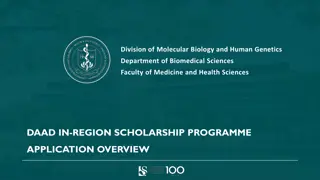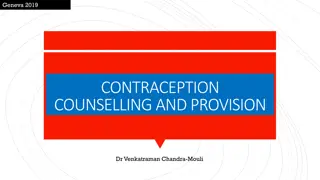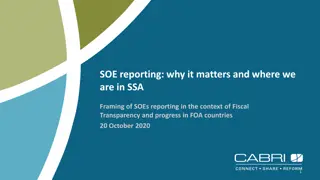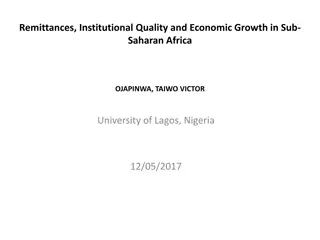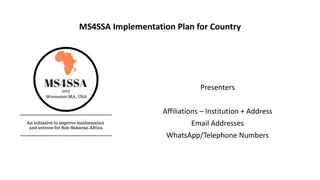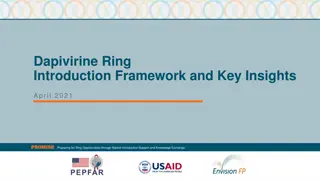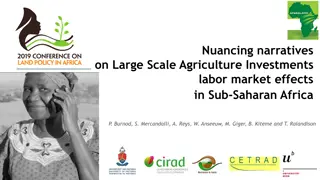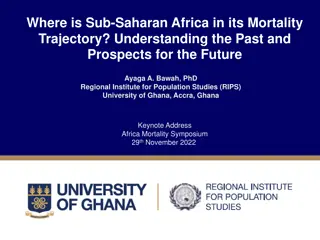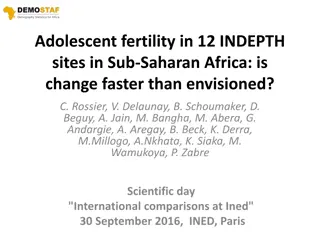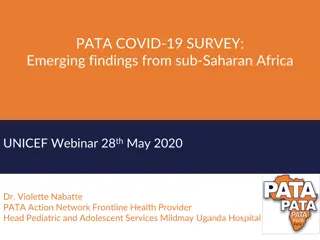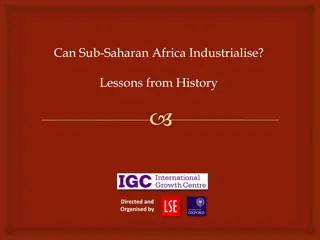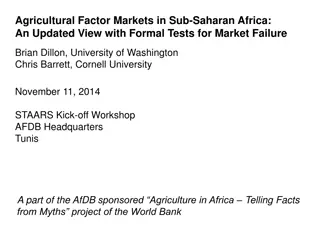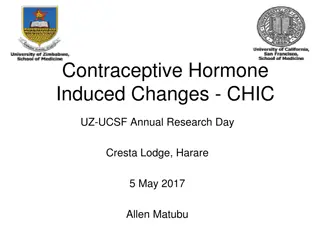Analysis of Hormonal Contraceptive Manufacturing in Sub-Saharan Africa
This study delves into the procurement and supply management of hormonal contraceptives in Sub-Saharan Africa, advocating for local manufacturing. It explores the financial implications, operational costs, and key assumptions related to setting up manufacturing facilities, using data from various sources in the region and industry experts.
Download Presentation

Please find below an Image/Link to download the presentation.
The content on the website is provided AS IS for your information and personal use only. It may not be sold, licensed, or shared on other websites without obtaining consent from the author.If you encounter any issues during the download, it is possible that the publisher has removed the file from their server.
You are allowed to download the files provided on this website for personal or commercial use, subject to the condition that they are used lawfully. All files are the property of their respective owners.
The content on the website is provided AS IS for your information and personal use only. It may not be sold, licensed, or shared on other websites without obtaining consent from the author.
E N D
Presentation Transcript
USAID GLOBAL HEALTH SUPPLY CHAIN PROGRAM Procurement and Supply Management Modelling the Case for Hormonal Contraceptive Manufacturing in Sub-Saharan Africa Authors: Zaki Hazzouri, Peter Stephens
Project Background and/or 2022 2021 Stand-alone Facility Stand-alone or Shared Facility Revised Business Case Preliminary Business Case USAID GLOBAL HEALTH SUPPLY CHAIN PROGRAM-Procurement and Supply Management 1
Approach Revenues Costs Factory Operating Costs Public Sector Private Sector Factory Build Product costs Other costs 10-20% of market Depreciation Interest and loan capital cost Information technology Insurance 80-90% of market donor driven in FP2020 Sub- Saharan African countries Salaries Repair and maintenance Land rental Regulatory Inspections Utilities Active pharmaceutical ingredient & excipients Packaging Registration fees Retention fees Distribution Marketing Engineering works Construction Mechanical, engineering, plumbing Equipment Environment controlled rooms Clean room fittings Quality Control Lab Validation Warehouse USAID GLOBAL HEALTH SUPPLY CHAIN PROGRAM-Procurement and Supply Management 2
Data Sources South Africa National Dept of Health, South African Health Products Regulatory Authority, nurse clinics, industry experts RHSC s LEAP report, 2019-2030, PMA reports (Uganda), USAID & UNFPA shipments Kenya KEMSA, Pharmacy and Poisons Board, commercial distributor, commercial provider, manufacturer South African tenders, data from Ethiopia and Kenyan procurement agencies Quantitative Data Qualitative Data DKT social marketing statistics, IQVIA private sector datasets (Kenya and South Africa) Ethiopia 4 manufacturers, procurement agency Prices from vial and carton manufacturers, equipment price lists, Indian import/export data for API, construction based on experience Uganda Private sector expert USAID GLOBAL HEALTH SUPPLY CHAIN PROGRAM-Procurement and Supply Management
Operating Costs: Key Assumptions Other, 2% Finance Depreciation, 7% o Commercial bank 16% per annum o Development bank 9.5% per annum o 10-year term, time to production & WHO Prequalification = 6 years Marketing & distribution, 23% Marketing & Distribution o South African private sector ~33% Single Exit Price o Others ~15% sale price Finance, 35% API & Excipients o Import price from Italy to India, 2019, small quantity Packaging, 6% Depreciation o 13% per annum (industry norm) Packaging o Sourced direct from manufacturers ~0.09 USD for primary, secondary and tertiary packaging Salaries, 5% API, 22% Salaries o Expatriates in managerial position + production operators o Salaries based on interviews with local manufacturers OPEX breakdown for stand-alone facility, development bank loan USAID GLOBAL HEALTH SUPPLY CHAIN PROGRAM-Procurement and Supply Management
Revenue Assumptions (Base Case) Market Share Price Subcutaneous form takes 50% of total Medroxyprogesterone Acetate 150 mg/mL, intramuscular injection (MPA-IM) demand; factory only makes vial South Africa 30% tender (National Dept of Health allocation formula) 20% private (historical analogues) FP2020 SSA countries Donor + Subsidised: 20% Non-subsidised: 12% Donor + Subsidised UNFPA catalogue price South Africa Public Sector Price to achieve 30% volume versus 2021 tender price South Africa private sector 20% discount to current MPA-IM Single Exit Price FP2020 Unsubsidised Average wholesale sale price for Kenya USAID GLOBAL HEALTH SUPPLY CHAIN PROGRAM-Procurement and Supply Management 5
Stand Alone Facility Profitability Stand-alone facility would not pay off a commercial or development bank loan over a 10-year term Stand-alone facility 17.3% -27.4% ? Commercial loan (Year 7) Loan repaid (Year 10+) -15.4% Development bank loan* (Year 7) *Assumed 10-year term; Ethiopian Development Bank (DB) will offer up to 20 years USAID GLOBAL HEALTH SUPPLY CHAIN PROGRAM-Procurement and Supply Management 6
Shared Facility - Profitability Shared facility Shared facility would pay off Development bank loan in 10-year term even if: o Interest rate increased by 2% (from 9.5% to 11.5%); or ? o Donor price fell by 15% from current UNFPA catalogue price; or 1.3% 21.8% o Share of South African public sector fell to 20%; or o WHO Prequalification, registration or peak market shares delayed by one year Loan repaid (Year 10+) Commercial Loan (Year 7) 6.1% Development Bank Loan* (Year 7) *Assumed 10-year term; Ethiopian DB will offer up to 20 years USAID GLOBAL HEALTH SUPPLY CHAIN PROGRAM-Procurement and Supply Management 7
Summary and Conclusions A stand-alone facility is likely not feasible o Would not be able to pay off loan within a 10 year term A shared facility is likely feasible o Profits are sufficient to withstand changes to key assumptions. Key points not addressed in this business case are: o Challenges in accessing foreign currency to pay for Active Pharmaceutical Ingredient, Excipient and packaging imports o Risk of expropriation or of instability in the selected country of manufacture o Potential expansion of subcutaneous presentation of MPA (MPA-SC) into South Africa or further reductions in donor prices paid in FP2020 Sub-Saharan African countries o The availability of matching funding (i.e. banks require ~50% co-investment) o The availability of a willing manufacturer to share facility/technological expertise o Expansion and sales beyond Sub-Saharan African FP2020 and South Africa In summary, manufacturing of an injectable contraceptive in Sub-Saharan Africa may be possible under certain conditions and further investigations with local manufacturers and development banks may be appropriate USAID GLOBAL HEALTH SUPPLY CHAIN PROGRAM-Procurement and Supply Management
Acknowledgements The authors would like to thank Denise Harrison and Jane Mwangi of the Office of Population and Reproductive Health at USAID, and Morgan Simon and Emily Day of the USAID Global Health Supply Chain Program-Procurement and Supply Management (GHSC-PSM) project for their comments and advice. The USAID Global Health Supply Chain Program-Procurement and Supply Management (GHSC-PSM) project is funded under USAID Contract No. AID-OAA-I-15-0004. GHSC-PSM connects technical solutions and proven commercial processes to promote efficient and cost-effective health supply chains worldwide. Our goal is to ensure uninterrupted supplies of health commodities to save lives and create a healthier future for all. The project purchases and delivers health commodities, offers comprehensive technical assistance to strengthen national supply chain systems, and provides global supply chain leadership. For more information, visit ghsupplychain.org. The views expressed in this presentation do not necessarily reflect the views of USAID or the U.S. government. Contact Information - Zaki Hazzouri: zaki@aps-me.org; Peter Stephens peter.Stephens@iqvia.com USAID GLOBAL HEALTH SUPPLY CHAIN PROGRAM-Procurement and Supply Management
